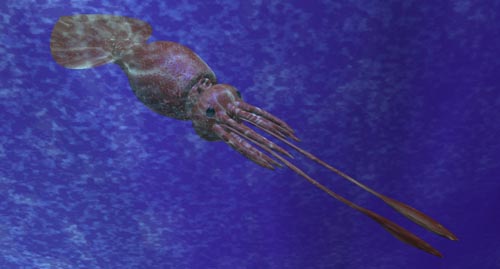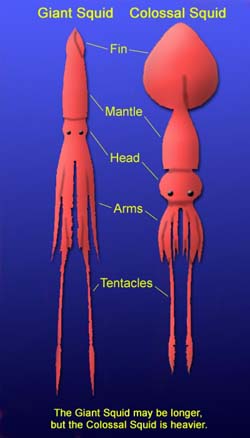|

The
Colossal Squid is thought to be even larger than the Giant
Squid.
|
Riddle: What has eight arms and two tentacles,
lives in the deep ocean and is bigger than a giant squid? Answer:
The Colossal Squid.
The Colossal Squid, Mesonychoteuthis hamiltoni,
is thought to be the largest of the squid species in weight, even
exceeding that of the famous Giant Squid,
Architeuthis dux. This species was first described in 1925
when two arms of the creatures were recovered from the stomach
of a sperm whale. After that very little was learned about the
Colossal Squid for many years as only a few incomplete or damaged
specimens were found.
In 2003 the colossal squid again got the attention
of the popular press when a nearly intact specimen was brought
up from deep Antarctic waters at a depth of over 6,000 feet. Just
three years later another specimen, a female 26 feet in length
and weighing 1095 pounds, was captured accidently by a fishing
boat near New Zealand in Antarctic waters. This particular animal
is thought to be the largest invertebrate animal ever found.
Scientists have reasons to believe that even larger
colossal squid might still be lurking in the deep than the one
captured by the New Zealand fishermen. "When we first examined
colossal squid specimens, we predicted that they might grow
to 1,100 pounds (500 kilograms)," said Chris Paulin of New Zealand's
national museum. "This specimen shows that they can grow larger
still, to maybe 1,600 pounds (750 kilograms)."
One clue to suggest that there may be bigger Colossal
Squids out there is the size of the beak of the New Zealand
specimen. While it is large, 40 millimeters (1.57 inches), even
larger ones measuring 49 millimeters (1.92 inches) have been
found in the stomach of sperm whales which feed on the squid.
 Colossal
Squid vs. Giant Squid
Colossal
Squid vs. Giant Squid
The Colossal Squid and the Giant Squid are similar
in many ways. Both creatures have a cone-shaped mantle topped
by fins at one end. Protruding from the bottom of the mantle is
a funnel through which the creatures can force water to propel
itself about. Also below the bottom of the mantle is the head
which houses the creature's huge eyes and mouth/beak. Radiating
out from around the beak are eight arms and two tentacles. The
tentacles are longer than the arms and widen at the very end in
a "club" shape. The tentacles are used to capture fish and bring
them to the animal's beak where they can be consumed.
Compared
to the Giant Squid the Colossal Squid seems to have a larger,
heavier body with shorter arms and tentacles. The club at the
end of its tentacles just doesn't have the suckers with tiny
teeth like the Giant Squid, but 25 swiveling hooks that allow
it to catch and hold very large fish. The eight arms of the
Colossal Squid also carry fixed hooks which the Giant Squid
does not have.
Both the Colossal Squid and the Giant Squid live
in deep water, perhaps as much as 3,300 feet (1000 meters) or
more beneath the surface, where there is very little light. To
help them hunt their prey in the darkness at that depth they have
extremely large eyes. The 2005 New Zealand specimen's eye sockets
were roughly the size of a small beach ball at 11 inches (28 centimeters)
across with lens the size and shape of an orange. To help conceal
themselves from other creatures at these depths, these big squid
are colored a deep shade of pink. When sunlight passes through
water the red wavelengths are more quickly absorbed, anything
near the bottom of the sea with a red or pink color, including
the Colossal Squid, will be virtually invisible. This assists
the squid as it hunts or hides from its main predator, the sperm
whale.
Both of these large squids are major sources of
food for the sperm whale. Scientists estimate the Colossal Squid
may make up 77% of the diet by weight of Antarctic sperm whales
feeding in the Southern Ocean. Even so, neither of these large
squid are an easy meals. Scientists have found the skin of sperm
whales scarred with sucker and hook marks from squid that clung
to the whale's body in a desperate bid to avoid being consumed.
Abyssal
Gigantisum
Large squids exhibit deep-sea gigantism,
also known as abyssal gigantism. Many animals living in
the depths grow to much larger sizes than their counterparts dwelling
near the surface. Some examples of these are the Japanese spider
crab which can have a leg span 13 feet wide and a body 15 inches
across; the giant isopod, a crustacean related to the shrimp that
can grow up to 15 inches long, and the whale shark which get as
lengthy as 40 feet. Scientists have several theories about why
these creatures get so big at the bottom of the sea. One is that
their food supplies are scarce and fragmented over large areas
so the animals need to be huge so they can range over great distances
to feed. Another is that the extreme cold of the depths is better
tolerated by large animals because they have much larger interval
volume compared to their surface area. With less surface area
to leak heat they can conserve their warmth better.
|
Colossal
Squid on Exhibit
The Colossal
Squid captured by New Zealand fishermen in 2005 was brought
to the Te Papa Museum in New Zealand to be examined and
mounted as an exhibit. It was a daunting job as the fishermen
had been forced to freeze the creature to keep it from spoiling.
Preserving the 1,000 pound creature, frozen in an even heavier
block of ice, was a huge challenge for scientists. The Te
Papa brought together an international team of squid experts
for the job along with their own staff. The trick was to
thaw out the creature completely without letting any part
of it rot. Scientists also wanted to be able to examine
the animal but not damage the carcass so it could be mounted.
The researchers solved these problems by using near freezing
salt water to slowly warm the remains and an endoscope,
a long flexible tube with a lens on the end, to see inside
the carcass without cutting it open. The Museum successfully
thawed the creature, injected it with preservatives and
expects to have it on display by December of 2008.
|
The specimen of the Colossal Squid captured in 2005,
though it was large, wasn't very old. Examination of the creature's
statoliths, or equilibrium organ, which has rings (much
like a tree's growth rings), indicates it had been born only 18
months earlier. The animal also appeared to be a less aggressive
creature than the scientists had first expected. Squid expert
Steve O'Shea, from the Auckland University of Technology, was
surprised to see the squid was an "enormous blob."
Monster
Blob
"We are looking at something verging on the incredibly
bizarre," Dr O'Shea said. "As she gets bigger she is reduced
to little more than a giant gelatinous blob." This growth probably
changed the creature's activity level. "Her shape was likely
to have affected her behavior and ability to hunt," added O'Shea.
"I can't imagine her jetting herself around in the water at
any great speed, and she was too gelatinous to have been a fighting
machine."
This isn't to say that the creature was harmless.
"I still don't want to be in the water with it," observed O'Shea.
He also notes it was probably a more aggressive hunter when
it was younger. "It's not sitting down there sipping on cups
of tea or anything like that," he notes. "It's got this arsenal
of beaks and hooks which at some stage in its life-cycle it
would have used."

Copyright Lee
Krystek 2008. All Rights Reserved.